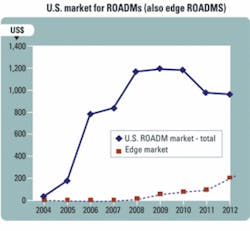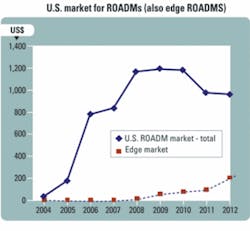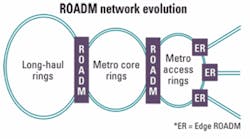by Clifford Holliday
Existing IXC networks, at almost every level, are conglomerates of various generations and types of technologies. To an extent this has always been the case, but it is more so than ever now because of the timing of the telecom burst at the beginning of this century and the relatively recent acquisitions of the major IXCs by the RBOCs.
Telcos (and others) were just beginning to implement new optical technologies (DWDM, optical switches, metro DWDM) when the burst occurred. We now have "stacked SONET" residing alongside DWDM and in some cases those platforms are alongside some type of "god box" and maybe enhanced SONET. Post-burst capital constraints prevented the initiation of any real replacement program for the older technologies. And while we were in an investment deep freeze, technology and product advances continued.
Capital started loosening up in late 2004. The years since then (through 2007) appear to have brought an even greater loosening of the capital strings, and this should continue in 2008 if the general economy does not stop it. However, in spite of a return to much looser capital, there is still a strong pressure for profitability, demanding expense containment.
In addition to the telecom burst and the resulting capital constraint that delayed updating of the IXC networks, the early days of 2005 brought a spate of acquisitions (SBC-AT&T and Verizon-MCI) that have all but eliminated the independent IXC business. The later merger announcement of AT&T and BellSouth has served to accentuate the trend. While these mergers offer many economies of scale, they also bring together existing, disparate networks. Now these two companies (AT&T/SBC and Verizon) are in the process of integrating their original long-haul assets with the newly acquired ones and integrating their metro facilities with the long-haul to allow seamless customer access. They seek operational efficiencies and elimination of duplication.
Elements such as next-generation DWDM, IP, next-generation SONET, and optical switches serve as building blocks for this integration -- but, more than anything else, reconfigurable optical add/drop multiplexers (ROADMs) are the key technology. The integration is directed at making the network more flexible and reliable and less labor intensive. In addition, the combined RBOCs are both deploying national networks for the delivery of video. These video networks will be the largest deployment to date of ROADM technology and thus have become the single largest driver for the ROADM market. As we at Information Gatekeepers discovered in researching our recent "ROADMs from the Core to the Edge" report, we are now on the road to ROADM-based networks becoming the standard.
ROADM evolution
ROADMs are systems that allow the very flexible, remote selection of wavelengths transiting a given intermediate node on a fiber network for dropping and/or adding. They allow access to any of the wavelengths going through a node (or, in more limited ROADM implementations, access to a set of the transiting wavelengths) for use of the data on the chosen wavelength and the possibility of adding to, or modifying, the data on that wavelength for transmitting it on to the next node(s). They also allow the interconnection of multiple intersecting networks (multiple-degree nodes) at the optical level, avoiding the expense and complexity of OEO conversions to achieve the interconnection. The platform offers the promise of substantial savings in operations costs and many operational benefits.
In the six or so years of ROADM history, we have witnessed a continuum of advancing capabilities and technologies:
The next step
The ROADM has become a standard part of long-haul infrastructures, to be included as a matter of course in any new network and sought after as a major update objective for existing networks. It has also become important to metro networks. In addition to the maturity of application, the WSS has quickly become the "gold standard" for ROADM technology.
To date the ROADM revolution has been largely confined to the core and, to some extent, to the major metro parts of the network. As we see demand increase for wavelength services (IPTV, video-on-demand, high-speed data, business services, etc.), carriers have recognized a need for wavelength control out to the edge of the network. This need has given rise to a new class of ROADMs -- the edge ROADMs described previously. These platforms are less capable than the core variety, smaller and, most important, cheaper. Figure 1, from "ROADMs from the Core to the Edge," illustrates how we foresee edge ROADM deployments will grow in the U.S.
Figure 2. ROADM technology is finding a home in long-haul, metro core, and increasingly in metro edge applications.
With deployment of edge platforms, ROADM technology will become ubiquitous in carrier networks. Figure 2 illustrates how the network will begin to look as edge ROADMs take hold.
Clifford Holliday is president of B&C Consulting and an analyst for Information Gatekeepers Inc.


